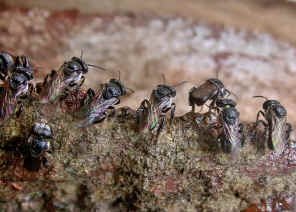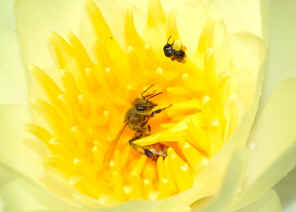Native Stingless Bee - Trigona carbonaria
Family APIDAE
This page contains pictures and information about Native Stingless Bees that we found in the Brisbane area, Queensland, Australia. They are also known as Australian Stingless Bees.

- Body length 4mm
- There are several Stingless Bees species look very similar, including Trigona sp. and Austroplebia sp. The species Trigona carbonaria is common in Brisbane.



- Native Stingless Bees are Australia Native Honey Bees, also known as Native Bees, Sugar-bag Bees and Sweat Bees. The bees are small in size and do not string. They are black in colour with hairy extended hind legs for carrying nectar and pollens.
Stingless Bees are active all year round in Brisbane. In winter there are less activities but will forge on warmer sunny day. They do not sting, but will defend by biting if their nest is disturbed.
Nest in Tree Log



- The first picture above shows a bee is heading toward home with the two baskets on its hind legs full of nectar and pollen. The second picture is the entry of their nest is at the tree trunk about 0.5 meter above ground. We can smell the honey meters away.



- Stingless Bees are social bees with large colony. They build their nest inside living or dead tree trunk. There are the queen, drones and thousands of worker bees in each nest.



- Inside the tree trunk their nest is constructed with the wax secreted by workers and the resins that collected from trees. In the nest there are the pot for honey storage and brood cells arranged in hexagonal pattern. An egg is laid by green in each cell and they will become larvae. They are provisioned with honey and pollen.



- The above pictures show more different Stingless Bee nests. Notice the short shelf-like projection at the rear of the thorax.



- The genus name Trigona refer to the triangular shape of the abdomen.






- Native Stingless Bees are long tongues bees. They have long tongues which allow them to reach the nectar in tubular flowers. Of course they feed on shallow flowers as well. Also notice the white hair on the side of the thorax.
Competition between Native Bees and Honey Bees



- The introduced Honey Bees always compete with native bees in Brisbane.
Drone



- Body length 4mm
- Pictures taken on Dec 2009 in Anstead Forest. There was a small group of them resting on grass stem. They had slender body, larger eyes and longer antennae. We think they are the Drones (male bees) Native Stingless Bees.


- Reference:
- 1. Native Bees of the Sydney region, a field guide - Anne Dollin, Michael Batley, Martyn Robinson & Brian Faulkner, Australian Native Bee Research Centre. P60.
- 2. How to Recognise the Different Types of Australian Stingless Bees: Second Edition - Anne Dollin, Australian Native Bee Research Centre, 2010.






